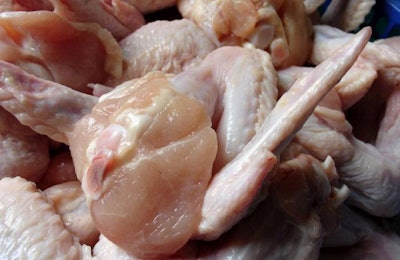
Ashley Peterson, vice president of science and technology at the National Chicken Council, spoke about the current and future regulatory challenges the poultry industry will face as the U.S. Department of Agriculture (USDA) and Food and Drug Administration (FDA) work to reduce the incidence of bacteria in poultry meat. The issues she highlighted at the Poultry Science Association’s annual meeting in New Orleans in July and Delmarva Poultry Industry's National Meeting on Poultry Health, Processing and Live Production in Ocean City, Maryland, in September will resonate with poultry processors.
Aiming to reduce Salmonella and Campylobacter on chicken
As part of its Healthy People 2020 initiative, the USDA’s Food Safety and Inspection Service (FSIS) is setting up goals to reduce Salmonella and Campylobacter infections. By 2020, it is targeting 11.4 cases per 100,000 people for Salmonella and 8.5 cases per 100,000 people for Campylobacter. According to the most recently available statistics, Campylobacter infections dropped to 14.3 cases per 100,000 people in 2011 from 24.6 cases per 100,000 people in 1997. Salmonella infections increased by 17 percent over the same time period.
The FSIS is shifting its focus, Peterson said, from whole birds to prepackaged parts because of shifting consumer preference. Regulatory agencies like the Centers for Disease Control, FSIS and FDA are all adopting full genome sequencing to track where exactly the bacteria is coming from and possibly pinpoint problem plants and processing locations.
5 key food safety issues to watch in the future
1. The updated chicken parts performance standard
The standard, which went into effect in July, focuses specifically on breast, wings and legs – because those parts account for about 60 percent of what goes into the marketplace – and ground poultry meat products. FSIS data shows whole chickens were the source of less than 30,000 cases of Salmonella and Campylobacter. Annually, about 180,000 cases originate from parts. Ground chicken accounts for about 13,000 cases.
Peterson said regulators are changing how they take samples – from a 52 day long process where a sample was taken every day – to a take one sample per week for 52 weeks to cover an entire year. The idea is to get a sample as close as possible to the consumer packaging. For chicken parts, the standard is 15.4 percent for Salmonella and 7.7 percent for Campylobacter. Starting in November, the sampling will also include half carcasses, quarter carcasses, necks, backs and giblets. A performance standard will likely be introduced for those parts in the near future.
As for ground chicken, FSIS remains focused on mechanically separated product. Mechanically separated poultry winds up in hot dogs and other fully cooked products or is exported for use in fully cooked products, she noted, but it is not incorporated into a ready to cook product because it must meet the performance standard for ground chicken. A performance standard for mechanically separated chicken might be looming as well.
2. Sharing performance data on the internet
This summer, regulators began to share the results of some processing plant testing online. Peterson said the information was publically available before through the Freedom of Information Act, but now categorized information for whole birds is available online. Performance data for parts and other products will start to appear next year. Aggregate categorization data on processing plants is available now. FSIS is also steadily releasing more detailed information about Salmonella and Campylobacter prevalence in poultry, pork and beef.
Peterson said this campaign is designed to make food safety data more transparent, answering growing consumer desire for a more transparent food system. Peterson said the policy originated in 2009 and reflects the public’s right to know about what’s going on inside a processing plant and help them make more educated decisions.
She said the data release policy creates the opportunity for consumers to misinterpret the data because they do not understand what the results mean. however.
3. The new poultry inspection system
Peterson said the new poultry inspection system is an optional program that will give plants more oversight over quality control issues with their products. It allows poultry companies to use their resources to focus on quality control and the government greater resources to focus on food safety concerns. The program aims to prevent 5,000 cases of Salmonella and Campylobacter annually.
Whether or not poultry processing plants opt into the new inspection system or not, all operations will need to do two things to demonstrate process control and prevention of contamination during the slaughter: address fecal and other contamination during the slaughter process and perform pre- and post-chill tests.
If a processor opts into the new configuration, plant personnel will replace inspectors in two locations: Serving as a carcass inspector at the end of the line, with the responsibility to check every single bird, and serving as a verification inspector, with the responsibility to monitor the entire line and ensure regulations are being followed. Line speed cannot exceed 140 birds per minute.
FSIS expected 189 establishments to opt in to the program and, as of August, 61 plants had opted into the new inspection system (46 are chicken processing plants, 14 are turkey plants). Only 47 of 61 have made the full conversion to the new system.
Peterson said the new system has its pros and cons. It allows a processor to set up its own operating standards and hire its own inspectors and it can help plants processing larger birds save time making their inspections. The system can also employ a roaming inspector, which can be a plus or a minus depending on the processor’s preferences. The new system requires hiring new personnel, which can have a financial impact on a facility.
4. Salmonella as an adulterant
The Center for Science in the Public Interest, a Washington-based consumer organization focused on food health, petitioned FSIS to declare four strains of antimicrobial resistant salmonella as adulterants in ground meat and poultry products. They said FSIS can do this because it has already declared a strain of E. Coli to be an adulterant in ground beef products.
Peterson said Salmonella is very different from E. coli and the strain declared an adulterant is much more virulent than most strains of Salmonella. Three years after it was filed, the USDA ultimately denied the petition for a number of reasons. Shortly after that decision, CSPI submitted another petition this time focused on all meat and poultry products.
No decision has been made on that yet, Peterson said, but there has been some communication about making Salmonella an adulterant in ready to cook chicken products that appear ready to eat like flash-frozen chicken cordon bleu and chicken Kiev products. Some consumers are confused because of their appearance, so the FSIS is considering making Salmonella an adulterant in those products to keep consumers safe.
Peterson said making Salmonella an adulterant is problematic for the chicken industry because the organism is so tough to control in poultry. She said it’s unlikely anything will happen on that front for a while.
5. Foreign materials
The presence of foreign materials is a large challenge for the chicken industry – more than the beef or pork industries – due to the small size of the parts in processing.
Peterson said the FSIS is conducting a review of foreign material procedures and how plants respond to consumer complaints. She anticipates the agency will have strong requirements for tracking products and will require a unified structure for handling reports of foreign materials entering processing. The agency is not overly concerned about one-time reports, but rather wants to avoid widespread instances. Processors shipping to institutions – schools, hospitals, military bases – will be expected to follow up on foreign materials complaints faster as well.
The NCC is working with other protein trade groups to come up with some general, industry guidelines concerning how foreign materials issues should be handled. The guidelines will likely feature recommendations for documentation, written programs for complaints, analysis of consumer complaints and how to respond when there is foreign material in commerce in order to reduce number of full-scale product recalls.


















